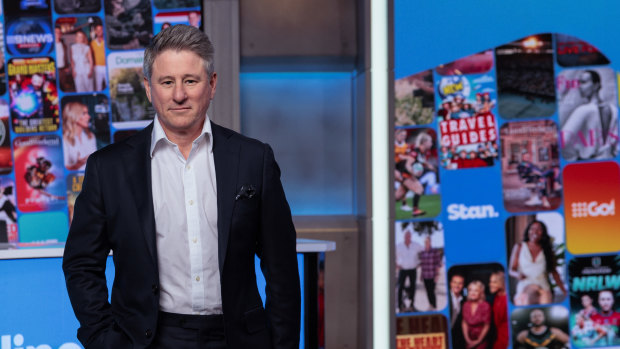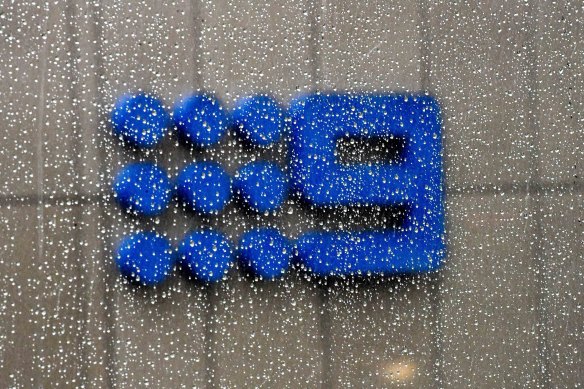This was published 3 months ago
Nine banks on broadcast shift despite profit slump
By Calum Jaspan
Media giant Nine has capped off a turbulent 12 months with a 31 per cent drop in profitability, but chief executive Mike Sneesby says its television division is reaching the point where digital growth can more than offset structural broadcast declines.
In a weakened advertising market, revenue from Nine’s “total television” division, which includes its free-to-air broadcast Nine Network and broadcast video-on-demand service 9Now, fell by $119 million, or 10 per cent, compared with 2023.

Nine chief executive Mike Sneesby.Credit: Dominic Lorrimer
“We expect, notwithstanding the cycle we’re going through and are in at the moment, that our total TV revenues are reaching an inflection point,” Sneesby said after the result.
“In other words, we’re at a point where we expect over the long term that the growth in BVOD [broadcast video on demand] revenues can more than offset structural declines in free-to-air television.”
Broadcast still made up 83 per cent of total television revenue, and while revenue from 9Now increased 8 per cent, it was outweighed by the sharp $132.8 million drop in broadcast revenue.
Nine owns the Channel Nine television network, talkback radio stations including 2GB and 3AW, streaming service Stan, as well as metropolitan news outlets including The Age, The Sydney Morning Herald and The Australian Financial Review. It is also the majority shareholder in the digital real estate business, Domain.
Nine, like other Australian media companies, has faced a number of challenges over the past year. Its traditional media segments have faced existential and structural challenges from the growing influence of digital giants such as Meta and Google, and increased competition for audiences and advertising revenue from global streamers such as Netflix and Amazon Prime.
Nine has also faced internal unrest, including a staff strike over a pay dispute and a sexual harassment scandal that rocked its TV division centred on former head of news and current affairs Darren Wick. Chair Peter Costello then departed after he allegedly pushed over a News Corp journalist who was asking questions about the turmoil.
Nine is due to deliver the results of an external independent review of its workplace culture specific to the television news and current affairs division in the coming month. The advisory firm Intersection is conducting the review. While Sneesby did not provide a date for the report’s publication, he said he and the company were prepared to take appropriate action regarding workplace behaviour, as it had already done outside the review.

Nine delivered its full-year results on Wednesday after a turbulent few months.Credit: Joe Armao
The ad market wasn’t just a drag on the company’s overall profitability but executive bonuses too.
Bonuses were slashed after the group failed to hit its EBITDA target of $533 million set by Nine’s board. Sneesby’s full remuneration package fell from $2.7 million in the 2023 financial year to $2.1 million.
Challenging conditions
Revenue fell 3 per cent to $2.63 billion amid what Sneesby said was a year of challenging economic and advertising market conditions, while the net profit result of $134.9 million was weighed down by $81.5 million in one-off charges, including inventory write-downs and restructuring costs.
Excluding those items, profit fell 22 per cent to $216.4 million.
Nine will take out about $100 million from its cost base over the 2024 and 2025 financial years. It lifted the price of subscriptions for its publishing mastheads and streaming service Stan in a bid to find new revenue.
Print revenue for the publishing sector fell 6 per cent but was largely offset by a 4 per cent rise in digital revenue for the metropolitan titles, led by an 8 per cent increase in subscriber numbers.
The publishing division delivered total EBITDA of $152.6 million, down 7 per cent. This made up 29.5 per cent of total group EBITDA, despite contributing 21.3 per cent of total revenue.
Eighty-five staff members from across the publishing mastheads will leave the business this week. The company has said the cuts follow a weak digital advertising market and the recent end of a commercial deal with Facebook and Instagram owner Meta.
Analysts said the result was in line with expectations. Nine’s share price was up 1.9 per cent by mid-afternoon on Wednesday.
Sneesby said he and new chair Catherine West, who is up for renewal at Nine’s annual general meeting this year, were aligned in their expectations for the company from a strategy perspective and the focus of the culture at Nine.
West, who succeeded Costello in June, said the media group had begun 2025 on a positive note “with a strong performance from an incredible Paris Olympics”.
Stan revenue increased 5 per cent, with EBITDA up 24 per cent. Paying subscribers increased to 2.3 million. Revenue from Domain grew 13 per cent to $391.1 million.
Nine said its Olympics coverage had delivered strong cross-platform audiences, helping boost expectations of a 10 per cent rise in metro free-to-air revenue for the September quarter.
It expects continued growth from Stan, but publishing revenue and earnings are expected to be down year-on-year.
Sneesby declined to comment on whether Nine was considering a takeover of News Corp’s majority-owned pay TV company Foxtel, which was recently put on the market.
The Business Briefing newsletter delivers major stories, exclusive coverage and expert opinion. Sign up to get it every weekday morning.